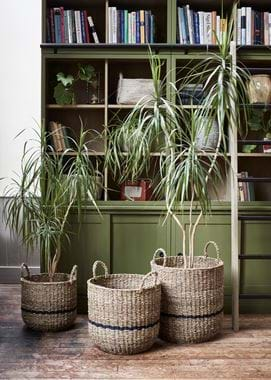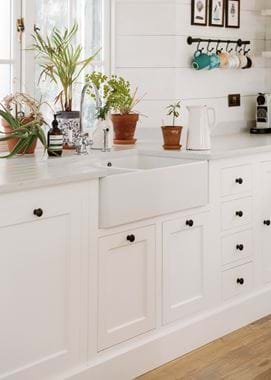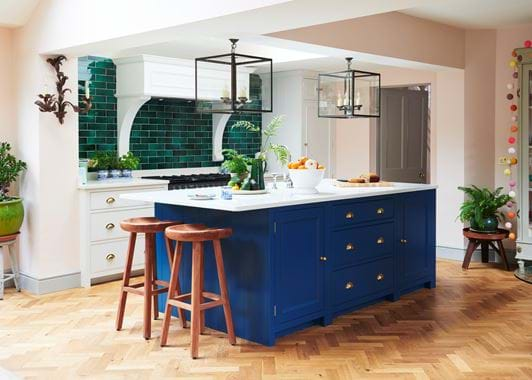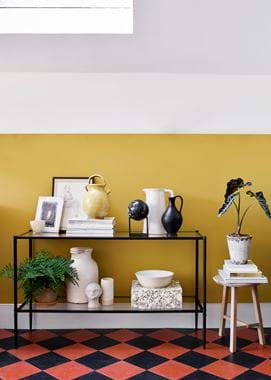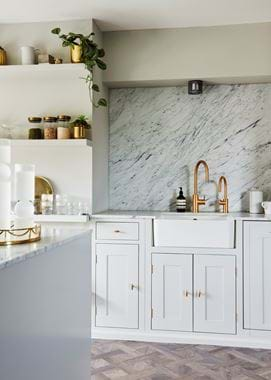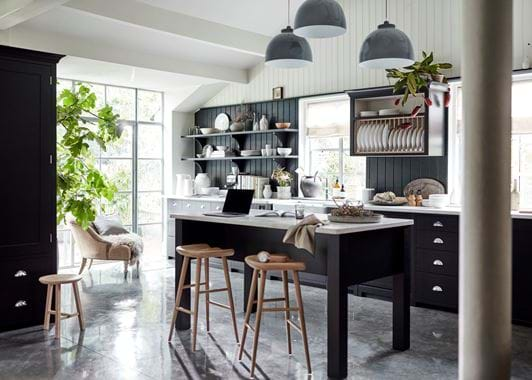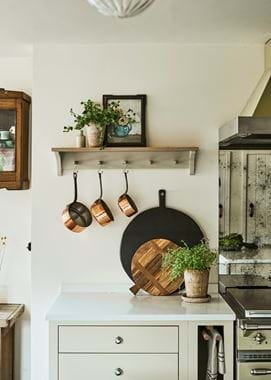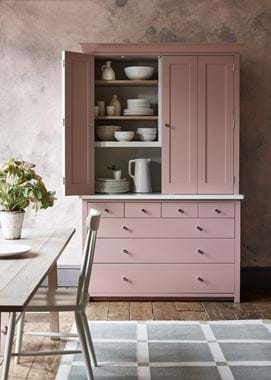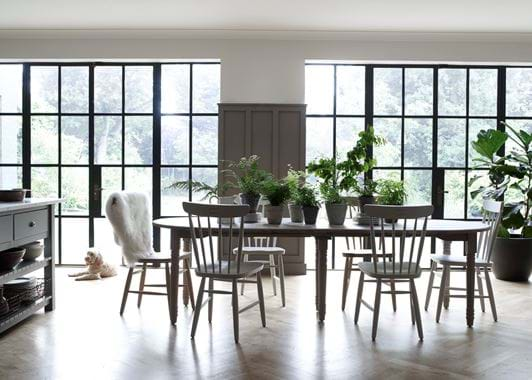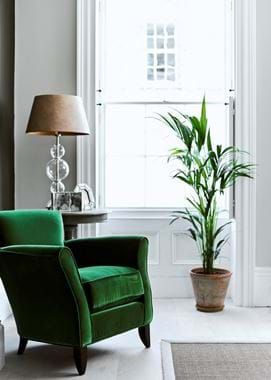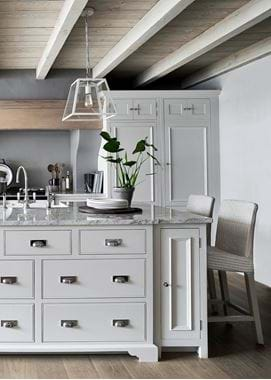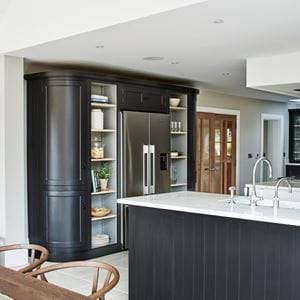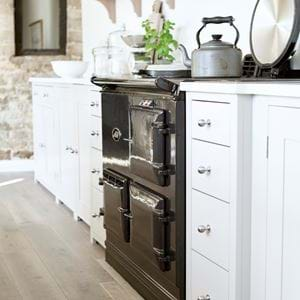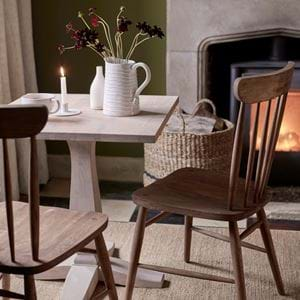The green kitchen: houseplants for the heart of your home
The green kitchen: houseplants for the heart of your home
Every kitchen should have a houseplant or two. Like any other room in your home, they bring life and vibrancy that nothing else can. But how (and where) to display plants in your kitchen? And which ones will suit this room’s often warm and humid climate? Read on for some of our favourite suggestions.
For shelves & sills
Let’s start at the top and work our way down. If you have open shelves in your kitchen, they can play host to all sorts of plants, and including them will help break up groups of crockery and glassware. But there are two types that’ll particularly benefit from this on-high position: trailing plants, and smaller specimens that might get lost elsewhere.
In the trailing category, there are ivies of course, but in reality, they tend to prefer cooler conditions than our centrally-heated kitchens can offer. Instead, opt for plants like Ficus and Philodendron that like a warmer, humid climate. Both these plants contain species that can grow much larger than you’d want for your kitchen’s shelves, so choose wisely. Ficus pumila and Philodendron scandens are good bets. Both also prefer the shadier spots and less direct sunlight that shelves often sit in, compared to a windowsill, especially the Ficus which really won’t like any bright sun. As steamy as kitchens can be, it’s also a good idea to mist the leaves of these plants regularly.
If your shelves are near to a window though, or you’re looking for a plant for the windowsill itself, then be sure to include succulents and cacti. These (usually) smaller specimens could feel a little lost on the expanse of a work surface or tabletop unless you arrange them as part of a group, and there’s something to be said for keeping the spikier varieties up out of the way. They’ll also thank you for the sunlight and summertime fresh air of a window-side location.. If yours is a south or south-west facing window though, just make sure to shade them a little from the heat of the midday sun. (It’s also worth mentioning that many succulents and cacti will benefit from being somewhere a bit cooler in winter. They’re pretty tough, so you may find yours are fine, but if they’re flagging, move them to a cooler but still bright and frost-free spot.)
There are seemingly endless varieties of each to choose, but it pays to think a little about positioning – opt for taller types like Aloe, Agave and Haworthia succulents and Opuntia, Echinopsis and Echinocereus cacti on higher-up shelves, with the shorter types that are best appreciated at close range (like Parodia, Astrophytum and Mammillaria cacti, and rosette-forming succulents such as Echeveria and Sempervivum or even the diminutive ‘living stones’ Lithops) on eye-level shelves or windowsills.
For tables and countertops
We think that the close-range of tabletops and work surfaces is a perfect opportunity to introduce scented plants to your kitchen, positioning them where you’ll come into contact with them every day. There are herbs, of course, which can also have a culinary use in your kitchen. Thyme, rosemary, basil and oregano are all classic choices – opt for varieties with attractive flowers as well, such as Thymus serpyllum, which creeps and trails too, and Greek oregano. We also like to include lemongrass and mint to make refreshing drinks (the lemongrass, in particular, will benefit from the warmth of your kitchen. Crush the stems and add to hot water for a fragrant tea, or simmer them with sugar, water and ginger to create a syrup that you can add to cool drinks). Rau răm, also known as Vietnamese coriander, is another slightly more unusual herb which looks like mint but is useful in the kitchen in all sorts of stirs fries and Vietnamese dishes as a substitute to coriander, which some people can find soapy.
The other sort of plants that’ll work well for counters and tabletops are those in-between plants that are potentially too large for shelves but too small for the floor. Phalaenopsis orchids are ideal, liking bright but not too sunny spots and the warmth and humidity your kitchen offers, as are peace lilies (which will thank you for a draft-free spot).
Pelargoniums are a particular favourite though, with their dramatic flowers and foliage – many can be coerced into flowering pretty much year-round if kept somewhere sunny and warm, and some have interestingly variegated foliage or a trailing habit. They can grow to be quite wild (in a lovely, romantic sort of way) which is why they’re perhaps best suited to a bit more space, although you could place them on a shelf too. Try ‘Surcouf’, which will gracefully spill over its pot, and ‘Marion Saunders’ for its mass of magenta and crimson flowers. And you’ll definitely want to include a scented-leaf pelargonium or two – like ‘Attar of Roses’ and ‘Prince of Orange’ – for their Turkish delight and sherbet-fragranced leaves, which make excellent teas and cordials. All these are relatively easy to care for – plenty of sunlight, not too much water and a less-steamy spot (perfect for the table, rather than near the hob).
For on the floor
If you have floor space available in your kitchen, then it’s a great place to introduce those larger plants too tall for any higher up surface but which can bring a real sense of drama to the space.
The fiddle-leaf fig, Ficus lyrata, has really grown in popularity in recent years (you’ll spot it in the corner of a few of our kitchen shots) and can certainly grow quite impressively tall. A good balance of plenty of light but not too much direct sun and allowing the soil to dry out a little before watering should stand it in good stead. With its smaller, more delicate leaves, the weeping fig, F. benjamina, is also a good one to look out for.
The Swiss cheese plant, Monstera deliciosa, may be a little ubiquitous, but don’t be quick to dismiss it. It’ll be very happy with the humidity of a kitchen, is excellent at air purifying, and its striking and graphic, glossy leaves can’t really be beaten – except, if you have room, perhaps by Alocasia portodora whose common name ‘upright elephant ear’ gives some clue to its size. The Monstera will prefer a bright but not too sunny spot, whereas Alocasia portodora needs all the sun it can get.
While most of these large, floor-dwelling houseplants are all about their dramatic foliage, there is one that combines that with some equally spectacular flowers: the bird of paradise plant, or Strelitzia reginae. The long and leggy stems of this plant are topped by slim, deep green leaves and then, in winter and spring, by orange and blue-purple flowers that look like (you guessed it) tropical birds. It’s not for everyone (or every space, needing a good amount of room to spread out), but it is a real showstopper.
Where to go for more information
Indoor plants can be temperamental, and while there are a few fairly universal rules to follow (too much watering, too much direct sunlight and no fresh air can all cause your plant’s untimely demise), there are places you can turn if you’re not sure how best to care for yours.
Patch
This London-based houseplant specialist not only has a wide array of potted plants that you can buy, but their website is also full of information about how to look after them, including helpful video tutorials. There’s even a plant doctor service for specific questions on plants you’ve bought from them.
The House Plant Expert by Dr D. G. Hessayon
This book may have been around for a while, but it’s still the most invaluable guide we’ve found to choosing and caring for houseplants. It includes sections on cacti, succulents and orchids too, but if you’re serious about the latter, they also have their own dedicated books in the series.
Herbarium by Caz Hildebrand
Even though this book is less about plant care, it is our go-to guide to herbs (for both inside and out). Beautifully illustrated, each herb has a spread to itself, and includes details on how to use it in the kitchen, the ingredients it pairs well with, and its health benefits.

